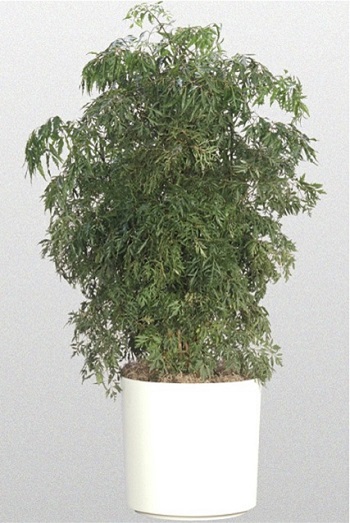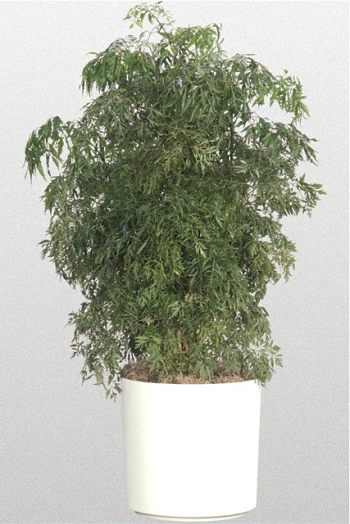If you have an open location think about using aralias for those corners of your home or office. The distinct leaves of this plant come in a large variety of leaf shapes and colors. There is the lacy Ming Aralia, the rounded leaves of the Balfour Aralia, or the crinkled dark green leaves of the Spinach Aralia to name just a few. The leaf coloration of different Aralias can be green, white, gold, cream, and variegated. Sometimes the green is so dark it appears almost black.
However, it is the thick woody trunks and interesting branches of specimen Aralias that really make this a distinctive plant. When small, in a 6” or 8” pot, an Aralia can be an exotic looking table plant. As they mature, Aralias in 17” or 21” pots can reach an impressive height of over 10ft. An Aralia isn’t a good choice for the novice plant enthusiast; it’s a little finicky and quickly drops leaves when not cared for properly.
Aralias Care
Light

Aralias will survive in low light conditions but grow faster and produce more leaves in medium to bright indirect light.
Water
Too much water, resulting in root rot, is the main reason Aralias die. To be on the safe side, allow the top 50% of the soil to dry out before watering. In low light conditions an Aralia may need water only every 2-3 weeks.
Fertilizer
Aralias are light feeders and require very little plant food. Fertilize every other month when the plant is actively growing with a plant food high in nitrogen at 1/2 the recommended strength.
Temperature
Like most indoor plants, Aralias do well in temperatures between 60-85 degrees.
Humidity
Aralias thrive in high humidity and will drop leaves if they are in an extremely dry environment. If the humidity in your home or office is very low, you may want to put a small humidifier in the room.
Pests
Aralias are more pest resistant than many other houseplants, but are still bothered by aphids, scale, and spider mites.
Diseases
Aside from root rot caused by over watering, Aralias are fairly disease resistant.
Soil
Aralias should be planted in a peat-based, well- aerated, light soil. This prevents water from accumulating in the soil and rotting the roots.
Pot Size
For such a large plant, Aralias do much better when root bound in a small pot. This also helps prevent overwatering.
Pruning
It’s important to prune back the tips of an Aralia; this promotes new growth and keeps the plant looking full.
Propagation
Aralias are usually propagated by stem cuttings. If the stems are thick enough, air layering is another propagation technique that can be tried. Either of these techniques is more successful when the temperature is above 70 degrees.
Toxicity
An Aralia is a non-toxic plant.
9 Fun Facts About Aralias
Aralia plants belong to Araliaceae plant family which contains more than 70 species.
The Aralia plant is native to Asia, Africa, and the Americas.
Some species of Aralia plants can grow up to 50 feet tall in the wild.
Aralia plants are known for their large, glossy, and deeply divided leaves that can be up to 3 feet long.
The Aralia plant is also known as the “Devil’s Ivy” due to its ability to grow in low light conditions and adaptability.
In some cultures, Aralia plants are thought to offer good luck and are often given as gifts to new homeowners or people starting a new business.
The Aralia plant has been used in traditional Chinese medicine to treat various ailments, including coughs, colds, and rheumatism.
Some species of Aralia plants produce small, white, or yellow flowers in the summer, followed by small, black, or purple berries.
Aralia plants are also popular as indoor houseplants due to their low maintenance and attractive appearance.
The Aralia plant is a popular choice for bonsai enthusiasts due to its small leaves and ability to grow in a variety of styles.
Related Articles & Free Email Newsletter Sign Up
How to Grow & Care for the Lipstick Plant
How to Propagate and Grow Fuchsias
Why Is My Chinese Evergreen Turning Yellow? And How to Fix It




Comment here